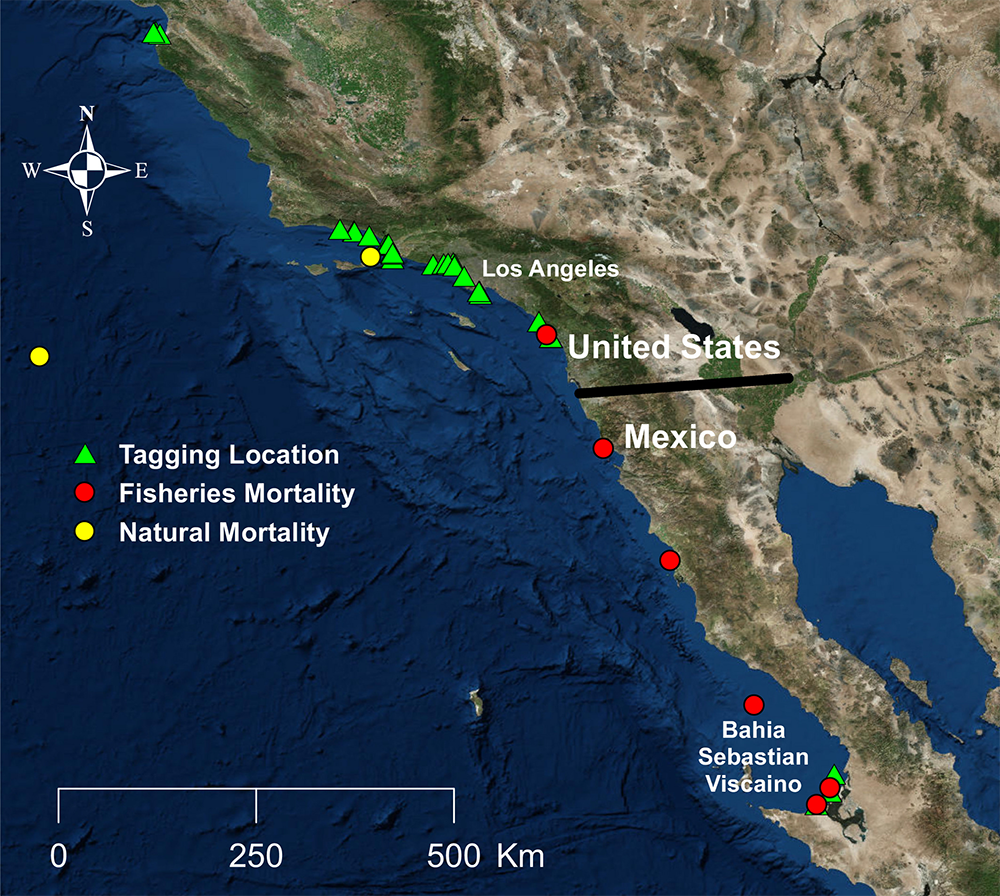
The data sat, for years and even decades, on hard drives, spreadsheets and screens.
It helped marine biologists better understand the migration patterns of sharks and other sea-dwelling creatures. But like the dorsal fin of a great white that draws every eye as its 2,000-pound body glides just below the surface, only part of the data’s potential had revealed itself to researchers.

John Benson, who works in the country’s only triply landlocked state and spends most of his time studying land-based predators, has helped unlock more of that potential by seeing what others had overlooked. His efforts could help conserve rare species and transform understanding of population dynamics among marine animals — starting with the star of “Jaws.”
An ecologist at the University of Nebraska-Lincoln, Benson and colleagues recently estimated the annual survival rate of young white sharks off the coasts of California and Mexico. That annual estimate is the first of its kind to be derived by tracking individual sharks — despite relying on a technology that’s existed since the early 1990s.
“Juvenile survival is understood to be really influential for population growth in white sharks and other shark species, but it’s been a very elusive parameter for all marine species,” said Benson, assistant professor of natural resources. “Now we’ve got a parameter that we can actually plug into a (mathematical) model. We feel like this is something that gets us a lot closer to building a realistic model and understanding those population dynamics.”
Benson teamed with researchers from the Monterey Bay Aquarium; California State University, Long Beach; and the Ensenada Center for Scientific Research and Higher Education in Baja, Mexico, who have tagged and tracked juvenile sharks since 2000. Together the researchers managed to distinguish between natural, predator-related deaths and those that resulted from getting accidentally trapped in commercial fishing nets or hooked by saltwater fishing lines.
That distinction helped reveal a trend: White shark juveniles appear to die from fishing-related incidents much more frequently off the coast of Mexico than near the shores of southern California. Five of the study’s six fishing-related deaths occurred in Mexican waters, the study found, including three of the four white shark juveniles that were tagged near the Mexican coast.

Because commercial shark fishing is illegal in both countries, Benson said, the stark difference probably reflects the success of a 1994 California ban on deploying nets within three nautical miles of the state’s coastline.
“That is mostly where juvenile white sharks are roaming,” said Benson, who co-authored a recent study on the findings in the Journal of Applied Ecology. “They’re close to shore at that period of their life, when they’re most at risk. It seems like keeping gillnets farther from shore is the best practice to reduce juvenile white shark mortality from accidental capture.”
By land and by sea
The team’s insights came by way of a widely used technology known as the pop-up archival satellite tag, or PAT tag, which has long helped track the movement of sharks, sea turtles, swordfish, tuna and other marine animals.
Water blocks real-time transmission between a PAT tag and a satellite, meaning that the tag cannot report its coordinates the way a GPS does. But the tag does measure the amount of light it’s receiving, and because the length of a day varies slightly even at nearby latitudes, that variable alone can help determine location. It also measures depth and surrounding temperature, which change substantially when a shark juvenile ends up in a fishing net or the belly of a predator.
“When it gets eaten by a predator, the light extinguishes,” Benson said. “You can also look at the movement data, and the pattern will be fundamentally different, because now it’s riding around in the predator’s stomach instead of swimming on its own. And the temperature should then reflect the internal temperature of the predator, so it should be warmer.”
After a predetermined amount of time, the PAT tag detaches from the animal, floats to the surface and transmits its data. Researchers have used that data to learn about seasonal migrations and estimate the short-term survival of animals released from fishing nets. With access to 16 years of data on young white sharks, though, Benson had a new idea.
“That was the surprising part,” said Benson, who began the work as a postdoctoral researcher at the Monterey Bay Aquarium. “No one had taken the next step and extended the short-term estimates to study the annual or longer-term survival that would be meaningful for understanding population dynamics.”
Yet the more Benson learned about the nuances of the PAT tag data, the more similarities he saw between it and the radio telemetry data he had collected from tracking mountain lions, wolves and other terrestrial predators.

“I thought we could use it to estimate survival in a much more direct way than had been done in the past,” he said. “It sounded a little trickier than data from radio collars, but everything sounded like it would work. So I said to my colleagues, ‘If you can get the data in a format that shows when we started and stopped tracking each shark — and what the fate of each individual was — we could have an estimate very quickly.’”
Having demonstrated this newfound potential of PAT-tag data, Benson said he hopes to see other researchers follow suit with the dozens of other marine species that have been extensively tagged over the past quarter-century.
That knowledge could answer all sorts of questions about the populations of potentially vulnerable species, he said. Among the most important: What’s the sustainable mortality rate of a given species? What proportion of a species can be annually harvested for food without putting its population near the risk of extinction?
“Maybe it’s a species like the white shark that isn’t harvested commercially, or maybe it’s a commercial species that is,” Benson said. “There’s always going to be uncertainty in the estimates, but you might be able to say, ‘This is a reasonable estimate, and we feel like the population can withstand this. (Or) this is too much, and we see negative consequences in the model.’
“It has taken decades for some of the heavily harvested fish species to come back following declines. If we have more information, hopefully we can avoid taking it to that level.”







